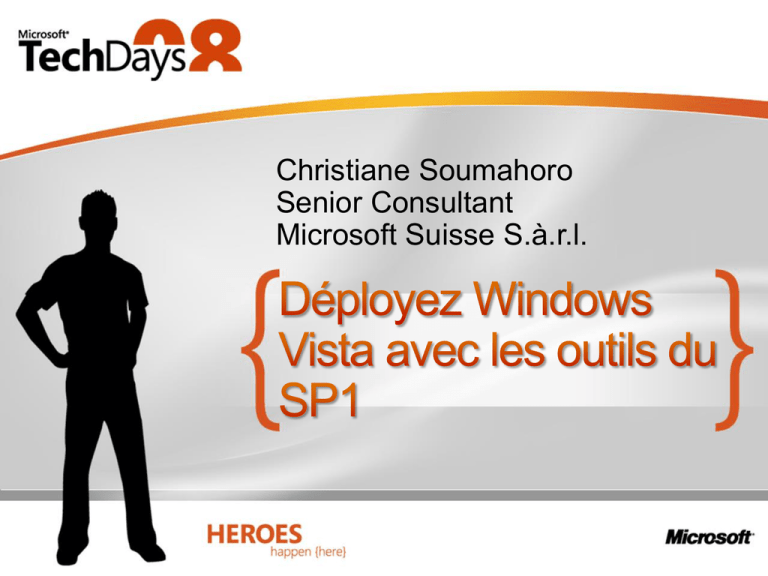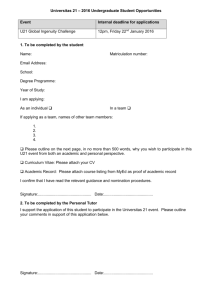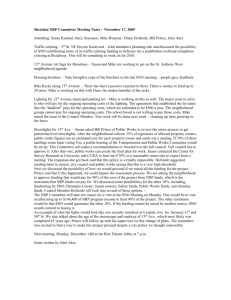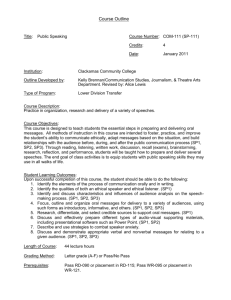
Christiane Soumahoro
Senior Consultant
Microsoft Suisse S.à.r.l.
Why and when deploy Vista SP1?
Vista SP1 changes
Vista SP1 installation methods
Vista SP1 deployment
Windows Vista SP1:
Support
for emerging
hardware and
standards
Infrastructure
Optimization
Quality Improvements
Device Compatibility
Application Compatibility
Reliability
Performance
Battery Life
Security
SP1 = Security Updates + Hot Fixes +
enhanced functionality for existing components
Brings improvements in areas most important
to our customers
No new features
SP1 Highlights:
Significant reliability improvements; fixes the
majority of OS and application crashes traced
to Microsoft software
Measurable performance improvements for key
scenarios like file copy, network copy, and
resume from Standby
Continued security improvements
BitLocker Drive Encryption Support for all local
volumes
Remote Desktop Protocol streamlined to use
25%-60% less bandwidth
February
March
Release to
Manufacturing
TechNet and MSDN
Subscriber
Downloads
Windows Update
Download Center
Download for VL
Customers
Media Kits mailed
To VL customers
Retail
Availability
English, French, Spanish, German, Japanese
April
May
June
Windows Vista SP1 include fixes for the
following situations:
Working with newer graphics cards
Connecting a laptop to an external display
Upgrading Windows XP to Vista
Transitioning between power states, such as
resuming from sleep
Filesystem improvements
Boot & Shutdown updates
Performance features updates
“Back to Work” updates
Longer battery life
Performance analysis tools
Xperf (command line)
Xperfview (Performance analyzer) (GUI)
Xbootmgr (command line)
Target Audience
System builders, hardware manufacturers,
applications & driver developers
BitLocker Drive Encryption (BDE)
Additional multifactor authentication method that
combines a key protected by the Trusted Platform
Module with a startup key stored on a USB storage
device and a user-generated personal
identification number.
Ability to encrypt local volumes other than the
system volume
Group policy management
Default is Group Policy editor (gpedit)
New group policy tool provided with RSAT
RSAT will be available in Q2 08
Extended Firmware Interface (EFI)
SP1 will allow x64 computers to boot using the
EFI.
Extended File Allocation Table (exFAT).
Transactional FAT (TransFAT) functionality
provides transaction protection for disk reads and
writes (analogous to the transactional capabilities
added to NTFS in Vista)
Speeds up storage allocation and supports OEM
extensibility so that OEMs can define parameters
to specify characteristics of a device, such as
performance, or create a unique ID (global unique
identifier, or GUID) for the device.
SP1 delivery materials, deployment
options, Updated tools
3 Delivery
materials
Windows
Update
Stand-alone
package
.EXE (SPC)
Integrated
installation
(“Slipstream”)
Windows Update
Availability on Windows Update in March 18th 08
Only applicable portions of SP1 downloaded
Standalone package
Available for Technet + subscribers
Will be Available soon @ Microsoft Download
Center
Installation Media
Part of the Volume License (VL) agreement is an
integrated build
SP1 will be integrated into the retail media
Available by language (like Vista RTM)
Windows AIK 1.1 includes new and updated
tools:
Window PE 2.1: updated Windows
Preinstallation Environment
Pkgmgr.exe: tool to install offline or online
updates, drivers
PostReflect.exe: tool to insert boot critical
drivers
VSP1Cln.exe: tool to remove Vista RTM files
Install SP1 via WSUS
Create a new image using SP1 slipstream
SP1 slipstream via BDD/MDT, WDS
SMS or System Center Configuration
Manager
Install SP1 online via pkgmgr
You cannot install SP1 offline
Reasons
1. The servicing stack needs to be updated.
•
Cannot be done offline when updates are pending
(which is typical for offline images).
2. SPs can contain updates for MSI-installed OS
components
•
These updates cannot be installed offline.
You will still be able to apply future non-SP
updates offline
1. Create an SP1 image
•
•
•
Install SP1 online
Sysprep /generalize
PostReflect.exe
•
•
•
PostReflect.exe must be run to match boot critical drivers with
changes to components. Without this, image will never boot
VSP1CLN.exe (optional)
Recapture
Logs you can use to diagnose
1.
2.
3.
4.
5.
6.
7.
"%windir%\\logs\\cbs\\cbs.log",
"%windir%\\logs\\cbs\\cbs.persist.log",
"%windir%\\winsxs\\poqexec.log",
"%windir%\\winsxs\\pending.xml",
"%windir%\\winsxs\\pending.xml.bad",
"%windir%\\inf\\setupapi.dev.log",
"%windir%\\windowsupdate.log“
Publically available sources to understand the logs:
Windows Deployment Error Diagnostic Guide
OCSetup Log Diagnoser white paper
Look for:
System codes: 0x8007nnnn (Winerror.h on MSDN)
CBS errors: 0x800fnnnn (common CBS errors)
Run if you
Want to reclaim disk space
Will not need to uninstall SP1
Functionality
Removes RTM files that have been superseded by
SP1 (leaving SxS, drivers & LPs)
Works in both Offline & Online modes
Offline: use WAIK or OPK version
Online: use %windir%\system32\vsp1cln.exe
Marks Sp1 package as permanent and invisible
Driven by a static list of superseded files
Size Saved on x86
Size Saved on x64
Space Saved (MB)
6,000
5,000
4,000
3,000
2,000
1,000
0
SKU
Some restrictions to consider. You cannot
Upgrade
previous versions of SP1. Must uninstall first
Uninstall
Permanent updates
KB937287: Service Stack Update
KB935509: Groundworks (Winload.exe)
KB938371: Prerequisite package
SP1 if you used integrated installation
SP1 if you have run the vsp1cln.exe
SP1 offline using pkgmgr.exe
You can
Uninstall non-permanent packages
KB936330: Service Pack package
KB937954: Changes to support SP coordinator
Uninstall SP1 online
Via Pkgmgr
start /w pkgmgr.exe /m:c:\temp\Windows6.0KB936330.cab /up /s:<sandbox>
Must be in Elevated mode
Control Panel -> Programs and Features
View Installed Updates.
Select Service Pack for Windows (KB936330).
Click Uninstall.
CEIP Functionality
collects basic information about computers and
how users use the product.
may collect limited info about software running
on the target in order to improve how SP1
interacts with that software.
Sends reports to Microsoft to :
Improve the features that are used most often.
Create solutions for common issues
Does not take actions other than those
described in the privacy policy
You can stop participating at any time after
installing SP1
During SP1 installation metrics are
uploaded
No personally identifiable information
Be part of the CEIP Program
You cannot install or uninstall SP1 offline
Close all apps before install
AV may fail SP1
NEVER hard reset during SP1
install/uninstall
Windows Vista SP1 on TechNet
Vista SP1 deployment notes
Windows Deployment Error Diagnostic Guide
Customer Experience Improvement Program
SP1 deployment Guide
OCSetup and CBS log diagnoser (see Common Errors)
The CBS Health Model
© 2007 Microsoft Corporation. All rights reserved. Microsoft, Windows, Windows Vista and other product names are or may be registered trademarks and/or trademarks in the U.S. and/or other countries.
The information herein is for informational purposes only and represents the current view of Microsoft Corporation as of the date of this presentation. Because Microsoft must respond to changing market
conditions, it should not be interpreted to be a commitment on the part of Microsoft, and Microsoft cannot guarantee the accuracy of any information provided after the date of this presentation.
MICROSOFT MAKES NO WARRANTIES, EXPRESS, IMPLIED OR STATUTORY, AS TO THE INFORMATION IN THIS PRESENTATION.



